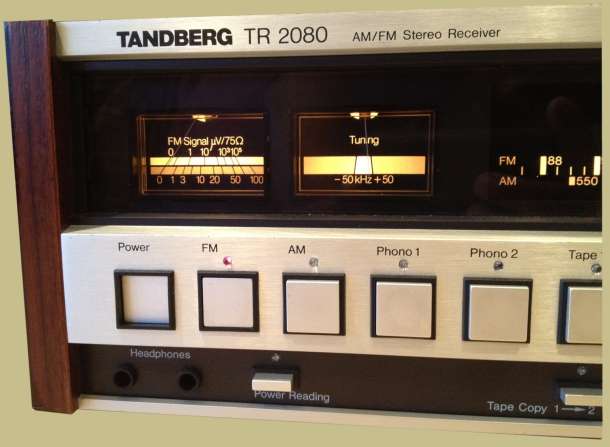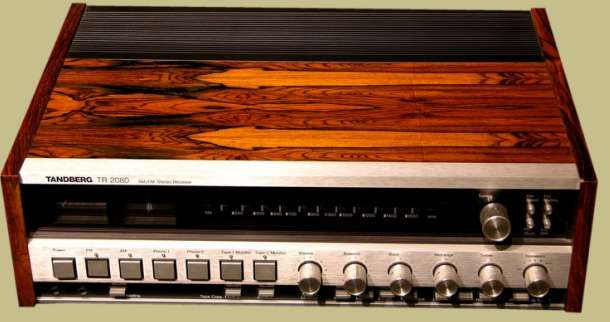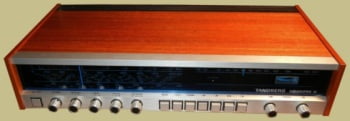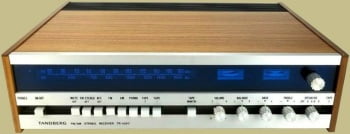
I’ve always though that Tandberg built some of the nicest looking receivers during the late 70’s. This Tandberg TR-2080 is no exception. The sleek design and logical layout are enhanced by it’s lighting scheme. Originally built in Norway from 1978 up in to the early 80’s, this receiver puts out 125 watts per channel into 4 ohms. The faceplate is aluminum and it came with wood cabinet in either natural wood grain or black.

The TR-2080 was one of Tandberg’s top of the line models and is known for its exceptional tuner. While not nearly as well recognized in the U.S. as the Pioneer, Sansui or Kenwood it can definitely hold its own performance wise with those behemoths.

Another interesting feature of the Tandberg receivers is that I see quite a few of them with fairly exotic veneer. I’m not sure if they came from the factory like that or were re-veneered by their owners. Given the number I’ve seen I’m leaning toward it being factory work. In fact, I’ve heard that the earlier versions of the Tandbergs had the more exotic grained veneer while the later versions utilized a more normal looking receiver veneer.

At one time I owned a Tanberg TR-2075 that I picked up at a garage sale for a few bucks. Once it was cleaned up it looked beautiful. I cleaned the pots and switches and it then sounded fantastic as well. The TR-2080 replaced the TR-2075 which was made from arouns 1975 to 1976 and supplanted by the TR-2075 MKII. The early TR-2075’s had blue dial lighting which looks great. Unfortunately with the TR-2080 the lighting scheme was changed and amber lights were used. Still, when it’s lit up it looks great. There is also a dimmer switch that will accent the lighting of the meters when switched.
The receiver below is an example of one with exotic veneer.

As I mentioned above these receivers aren’t that well known here so bargains can still be had. But, that won’t last long. Their unique styling and great performance will push demand higher over time.


I have a Tandberg TR-2080, the pots and the knobs, need a clean and maybe replacing. What did you do to clean up these on the Tanberg TR-2075? do you know anyone who has replacement parts that would match the originals should I need to replace them? It currently sounds scratchy when I turn the pots and the sound is generally fuzzy.
Thanks
Chris
Hey Chris,
I used De-Oxit to clean the potentiometers in the Tandberg. If I remember correctly I took the case off and just sprayed some De-Oxit into the tiny hole in the side of the Pots. Then moved the knob back and forth about 50 times. Cleaned them up nicely. Completely got rid of the scratchiness.
I have a Tandberg TR-2075 myself and I love everything about it, not only because of the music quality, but I’m a norwegian too.
The Veneers are in fact factory made of exotic wood, the flamed one up above is palisander (brazilian rosewood), others were teak or walnut. Tandberg also used oak on treir TR’s
Hope this was of help
March 23, 2014
I picked one up at my local “Dump”. Of course the pots were very dirty and 2 rounds of contact cleaner were necessary to get them to a listenable condition. I marveled at the modular design they used making disassembly pretty straight forward. If you find one and decide to clean the pots do yourself a favor and take a photo of every step. You can’t go wrong. Great sounding amplifier. Mono FM switch is great for those living in Rural locations. Tape switch functions are more than you’ll ever need.
Hello
What is the correct amperage for the stereo bulb for the TR 2070 tandberg
24V, 50mA, G3.5 MES base
I have two great Tandbergs. A “2045” (mid-power) one I bought as demo unit in 1982 with a Beautiful rosewood case – used it for years as main unit – now my bedroom unit. And more recently picked up a “2080” (the big one!) – great sound too. Cleaned it all up – & had a pro guy work on it some so essentially like new now (as my 2045 is too.) These are very nice classic units – and good looking too. (My stereo pro guy thinks these about the best sound out there from the “classic era” — and he recently scored a nice “2060” model for his own home.
Hello , name is William. Just picked up a tandberg TR 2080 , have not turned it on yet, is there anything i need to do before firing her up . Thanks, William
I have been involved with audio since I was about 11years old in 1968. As I went through college during the mid ‘70s I worked at a local hifi shop in Trenton New Jersey called House of HiFi. The proprietor had been a long tome hifi guy from the ‘50s and was friends to and associated with many of the great high fidelity original heavyweights such as Frank McIntosh, Rudy Bozak , David Hafler etc. As you would expect we carried many fine product lines from McIntosh, Bozak, ADS, Thorens, Luxman etc. This is where I began my lifelong association and appreciation of Tandberg high fidelity products.
While we usually kept our reference gear ( mostly McIntosh and Luxman seperated on the “main demo” shelves we frequently swapped a Tandberg Tr-2075 in their stead. In many ways the Tandberg receiver bested some of the seperates in terms of tonal evenness and long term listenability and of course integrated 3 high quality components into one fairly compact chassis both space and cost efficient, and of course ….. that gorgeous Tandberg aesthetic! Although not cheap, I believe about $1,200 in 1977 money, even then we recognized the Tr-2075 as an outstanding bargain.
I have owned many, many audio components over the years and I can say without hesitation that to a component Tandberg products , all I have experienced at least , have always exhibited a certain level of musical rightness that is many times absent in like competing products.
Tandberg engineering has been very creative and innovative and focused on ,above all ,musical value.
While I would posit that ALL Tandberg receivers are worth their asking price just for the tuner section alone ( easily outperforming many stand alone seperate tuners) it is the preamp/ amplifier sections that set them apart especially from the TR-2075 forward. When design engineers started to design with solid state devices in the mid ‘60s and realized that transistors were very linear in the current gain mode but not as voltage gain devices ( just the opposite of vacuum tubes) questions started to arise as to why so many solid state amplifier designs measured much better than their tube design counterparts but sounded much worse.
Tandberg was one of the audio companies that took part in the research into why this was so.
Dr. Matti Ottala was one of the leading voices to recognize that open loop linearity ( well behaved amplifier performance before the use of negative feedback) was essential for the elimination of transient inter modulation distortion which he felt was a major contributor to the early ‘ transistor sound’.
Tandberg and Dr.Ottala worked together and it is likely that together their design philosophies shaped the musical ‘Tandberg’ sound. To this day many notable high end audio companies such as Ayre Acoustics and D’Agostino Master Audio Systems follow this concept and shape their designs accordingly. I have a retail business ( not audio) and always have music playing in the showroom via a vintage audio system and while I have many vintage receivers swapped in and out of the system from Sansui, Kenwood , Pioneer and Luxman , it is always the Tandberg TR-2080 that I come back to for musical satisfaction. By far more ease and pleasure in listening, more depth, atmosphere and ‘meat on the bones’.
Tandberg also pioneered many other unique technologies in tuner design such as the worlds best varactor tuner , ‘Actilinear’ active tape recording equalization, special EQ curves for tape recording and adjustable recording head azimuth and closed loop dual capstan tape drive in cassette decks to name but a few..
I have owned many Tandberg products over the years a TR-1040, TR-1055, TR-2075, TR-2080, TPT-3001A, TCD-310, TCD-3040 TD-20ASE and others and I can confidently say that I will continue to pursue others!
FMG
Thank you for this very interesting post!
I have the same impression about Tandberg sound quality, but did not know about the design aspects and Dr Ottala.
Hello
“Nothing sounds like Tandberg” used to say a classmate who introduced me to the brand in 1978. That was in Ann Arbor, Michigan. So I purchased a 2075 mk ii receiver with a Thorens TD 126 turntable and A pair of KLH speakers whose model # do not remember.
The sound was so emotional and involving that I could not believe my ears. At night I used to listen to FM. It was so good, better than the McIntosh MR-78 regarded by many the best tuner in the World, that I installed an outdoor antenna on top of the roof in order to get the Chicago Symphony Orchestra Concerts. Chicago is 300 kms from Ann Arbor.
I’ve gone through a long journey with high-end audio: Audio Research, Sonic Frontiers, Pass among others and keep coming back to the Tandberg sound. Right now, the heart of my system is the TCA 3018A premplifier, the best preamp made by Tandberg, discrete components and of course NO negative feedback. I believe it is the best preamp ever made. A few tube preamps have mids in the same league, but do not match the bass performance of the Tandberg. It is like adding a high end sub woofer to the speakers. I am not exaggerating a bit.
I also have a TR 2080 receiver that’s not working. I thought of sending it to the Sound-Smith, but they are closed hard hit with Covid. Peter Lederman was hospitalized
Nice write up. I had posted a few steps above you about my Tandberg “2045” (bought new in ’82) and my (bought used) Tandberg “2080” I also had a Tandberg R to R tape deck from the early 1970s. Sounded good but the “transport” took work to stay reliable.
Still use my Tandberg “2045” Receiver – as bedroom system. Use it with CD player – cassette deck – and Bowers & Wilkins small but nice “CM1 S2” speakers. It sounds great! And my (big) 1980 “2080 model in finished basement – with Polk LSiM 703 speakers – also good.
(A “2045” retailed for $585 in 1980-81 – I got “demo” unit for $450. And the big “2080” one cost $1200 in 1980 (I have Orig receipt for that one)
Stereo equipment was a huge deal for us in the (say) ’74 thru ’81 period. Some good stuff then. Best music came first (1963-1973) – followed up by good equipment to play it on! Some of the neatest (and widely available) consumer electronics ever came out in the 1974-1981 period.
I am long time Tandberg owner/fan (see above posts) But recently I worked on a 1978 Pioneer “SX-980” receiver for the local vintage record shop. (An old guy just came in and gave it to them)
After my work – it’s now in place doing it’s thing at the Shop & sounds good. While not quite in Tandberg league maybe – I have to say that I was impressed by it. Has a pretty “full” sound when cranked up – and the FM reception is quite good also. Perhaps the “980” is one of the better Pioneers? It has 4 meters on it (2 power – 2 tuning) which adds to the appeal.
All these Receivers are now older & so they often need some work (and clean up) Not the fault of the units so much – 40-45 years old now (and sometimes folks haven’t cared for them well.) you get the rifght one with the right speakers and the sound is hard to beat!
I also agree that earlier transistor receivers (say 1965-1974?) were not great. (Some like tubes still – like the Fisher 500c!) But once the manufacturers got going with solid state they got better. (by about 1975 the better ones were – well – better)